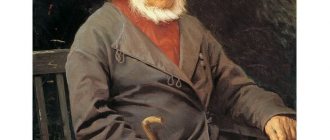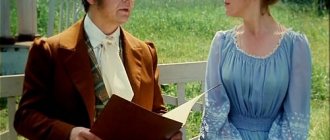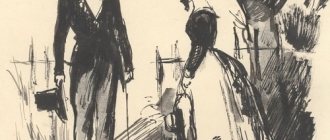Chapter 1. Curriculum vitae of Professor Persikov
Professor of zoology Vladimir Ipatievich Persikov holds the position of director of the Moscow Zoological Institute. At 58 years old, the scientist is still single. His housekeeping is run by his old housekeeper Marya Stepanovna. Persikov's real passion is amphibians.
In 1918-1922, the professor, like the entire scientific community of the country, had to go through difficult times. All the institute animals and the watchman Vlas died of hunger. Persikov lectured in a classroom at a temperature of -5°C. But by April 1928, life was getting better again.
Summary
Chapter 1. Curriculum vitae of Professor Persikov
The beginning of the “terrifying catastrophe” can be considered the evening of April 16, 1928, and its cause is professor of zoology Vladimir Ipatievich Persikov, who holds the position of director of the Moscow Zoological Institute.
At 58 years old, having survived his wife’s betrayal, Vladimir Ipatievich lived a modest bachelor’s life. Like all representatives of the scientific community, food had to endure many trials in the post-revolutionary years. Not only all the experimental animals at the institute died from prolonged starvation, but even “the permanent guard of the institute, old Vlas.” The professor had to give lectures at sub-zero temperatures in the room, and out of five rooms in his apartment, he was left with only two.
The professor threatened to go abroad, but did not keep his promise. By 1928, the situation began to improve noticeably, and Persikov perked up.
Chapter 2. Colored curl
The professor examines the results of his many experiments. Under a microscope, he observes the amoebas and notices a “colored whorl like a woman's curl,” a colored beam of light indicating that the specimen is out of focus.
Persikov wants to adjust the lighting, but his hand freezes halfway: the professor's eye notices something amazing under the glass. In a state of extreme confusion, he draws the curtains, covers the microscope with a glass cover and leaves the institute, muttering to himself: “This promises God knows what!”
Chapter 3. Persikov caught
The professor finds out that under the influence of a thin red ray falling out of a colored curl, the amoebas multiplied rapidly, and then “furiously attacked each other and tore them to shreds and swallowed them.”
To repeat the unusual effect outside the microscope, Associate Professor Ivanov undertakes to build a special system of mirrors and lenses. The device is ready, and already two days after the first experiment on frog eggs, the institute is filled with thousands of huge croaking creatures. With great difficulty it is possible to “kill them with poisons” and clean the room.
Chapter 4. Drozdov's priest
Rumors about an extraordinary “ray of life” are spreading at rapid speed throughout Moscow. A fashionable journalist, Bronsky, with his ever-moving eyes, visits the professor.
Despite Persikov’s resistance, the lively journalist asks him questions and comes to the conclusion that his discovery “will cause a world revolution in animal husbandry.”
The article immediately goes to print, and the next day journalists begin to besiege the professor.
Chapter 5. Chicken story
Meanwhile, in the “county provincial town” of Steklovsk, there is trouble: a terrible chicken pestilence begins, which wiped out all the chickens in the city in two days.
Professor Persikov continues to be harassed by journalists, and “it was simply impossible to work in such an environment.” Brought to the extreme of irritation, Vladimir Ipatievich calls the Lubyanka and asks to take action. He is assured that “no one will disturb him anymore, either at the institute or at home.”
Journalist Bronsky informs the professor, who does not read newspapers, about the chicken epidemic, and he joins in the fight against it.
Chapter 6. Moscow in June 1928
All of Moscow is covered with notices banning the consumption and sale of chicken eggs and chicken meat. You won’t find dishes with these products in simple canteens or expensive restaurants.
The “chicken” theme is becoming incredibly fashionable in the capital, and it is being played out in every manner not only in newspapers, but even in theaters and the circus.
Chapter 7. Rokk
Two weeks later, the chicken pestilence stops as unexpectedly as it began. During this time, “Professor Persikov became completely exhausted and overworked.” Having finally received the opportunity to study the amazing beam, he spends nights “at the camera and microscope.”
On instructions from the government, Alexander Semenovich Rokk, director of the Krasny Luch state farm, comes to the professor. He takes the experimental beam chambers from the laboratory, leaving only one, the smallest one. Rokku needs the cameras to restore the chicken population.
Chapter 8. History at the state farm
Alexander Semenovich and his assistants are installing precious cameras in the former Sheremetev greenhouse. He carefully places eggs sent from abroad into them. The only thing that confuses Rok is that they are all surprisingly large and dirty.
Rokk cannot stop looking at the “spotted bright red eggs,” in which already on the third day one could feel the awakening of life. However, the director’s joy is darkened by the strange behavior of the animals: all the birds and frogs disappear from the surrounding area, and the dogs howl pitifully all night long.
The day passes "extremely excitedly" as Rokk finds neither whole eggs nor the long-awaited chicks in the chamber. Everyone goes in search of them, during which Rokk's wife is attacked by a huge snake and eats her.
Chapter 9. Live porridge
In front of the GPU agents is a “gray-haired shaking man” - this is Alexander Semenovich Rokk, before whose eyes his wife died a painful death.
The agents invite Rokku to go to the state farm for investigation, but the old man, in horror, asks to be taken to Moscow. It is decided that the director is a madman who was frightened by a boa constrictor that escaped from the circus.
The agents go to the “Red Ray” and a picturesque picture opens before their eyes. “The whole greenhouse lived like a wormy mess”: giant-sized snakes crawl along the floor, hiss and curl up in balls.
The agents try to escape, but become victims of hellish creatures.
Chapter 10. Disaster
Moscow is full of extraordinary rumors about the invasion of giant snakes, ostriches and crocodiles. Professor Persikov, who, as you know, does not read newspapers, knows nothing about this. He is outraged by another circumstance: instead of a long-standing order for the supply of ostrich and anaconda eggs, he received a huge batch of ordinary chicken eggs.
The matter becomes clearer when a frightened Ivanov runs into the professor’s office with a newspaper in his hands: the professor’s “order for snake and ostrich eggs was sent to the state farm, and chicken eggs” to the institute. Realizing the scale of the tragedy, Persikov feels bad.
Chapter 11. Fight and death
A “mad electric night” is burning in Moscow: people are evacuating in panic, the cavalry army is unsuccessfully trying to stop the onslaught of huge reptiles.
A maddened crowd breaks into the institute, kills Professor Persikov and sets the building on fire.
Chapter 12. Frost god on a car
An unexpected salvation for Moscow and surrounding areas are unprecedented frosts that last for three days. Only severe frost could “stop the movements of the vile reptiles” against which the army was powerless.
However, it takes a long time for the country to recover from Rocca’s terrible experiment: the rotting of “countless corpses of crocodiles and snakes” causes a wave of terrible epidemics. Only by the spring of next year will the situation finally stabilize.
A new building is being erected on the site of the destroyed institute, and Professor Ivanov becomes its director. He unsuccessfully tries to recreate cameras with a “ray of life”: this secret was taken to the grave by “the late professor Vladimir Ipatievich Persikov.”
Chapter 4. Drozdov's priest
It is unknown how, but rumors about miraculous “rays of life” spread throughout Moscow, and soon the journalist Bronsky comes to the professor. Persikov does not want to accept him, but the arrogant reporter ignores all objections and bombards the scientist with provocative questions. The professor is at a loss under the pressure of the journalist and admits that he has found something amazing.
An article appears that talks about the incredible prospects of a new discovery for animal husbandry. Journalists begin to besiege Persikov.
The history of the creation of a fantasy story
The work was written in 1924.
In it, Mikhail Bulgakov expressed his attitude towards the confusion occurring in the country at that time, when completely incompetent people became managers.
The story was published in the magazine “Red Panorama” in 1925. The original title “Ray of Life” was later changed to “Fatal Eggs”. Bulgakov describes events that allegedly occurred in 1928 in Moscow and the Smolensk province.
It is interesting that Professor Persikov has a prototype - the doctor Pokrovsky, who was a relative of the author. One of the locations chosen was the Smolensk region, where Bulgakov worked in a hospital.
Chapter 5. Chicken story
In the small town of Steklovsk, in the chicken breeding cooperative of the widow Drozdova, a chicken pestilence begins. Soon the epidemic spreads to the neighbors' chicken coops, and two days later there is not a single chicken left in Steklovsk.
Reporters continue to besiege Professor Persikov and interfere with his work. The last straw is the visit of a foreign representative who offers the scientist money and support from “one country.” Evil Vladimir Ipatievich kicks out the foreigner and calls the Lubyanka. From there, experts come and assure that no one will disturb the professor again.
But the emergency situation with the chicken pestilence forces Persikov to join the fight against the epidemic.
Chapter 7. Rokk
After just two weeks, the epidemic stops on its own, despite the measures taken: not a single chicken remains in the Union. Commissions to combat chicken plague are quickly renamed chicken breeding commissions. Completely exhausted, Persikov, who was haunted by all these meetings and sessions, returns to the study of “living rays”.
Alexander Semenovich Rokk, who was appointed director of the Red Ray state farm, comes to the professor. On instructions from the government, he removes new large chambers, leaving Persikov one small one for experiments. Rocca's goal is to restore the chicken population.
Chapter 8. History at the state farm
The cameras are installed in the former greenhouse of the Sheremetyev estate. Following them, a batch of eggs is brought from Germany, very large and for some reason dirty. Persikov is indignant: his order has not yet been delivered, but everything has already been delivered to Rokka. The scientist doubts the success of the experiment; the effect of the red ray has been studied too poorly so far.
Within three days, the chicks are knocking in the eggs treated with the “rays of life.” Rokk's joy was slightly overshadowed by the fact that all the frogs and birds had disappeared from the area, and the dogs howled terribly all night.
In the morning it turns out that two eggs are empty, but the hatched chickens are nowhere to be seen. Rokk and his wife go to the pond. On the way, they are attacked by a huge snake, which eats the unfortunate woman.
Substitution
In turn, Rokk from the same abroad orders chicken eggs for his state farm purposes of raising chicken farms. And then something terrible happens, as it turned out later, on the way the orders were mixed up, and the eggs of creepy animals fall under the experiment of the Smolensk state farm.
Unsuspecting Rokk places strange-looking eggs in a special pressure chamber. And surprisingly, after a while the frogs on the state farm suddenly fell silent, all the birds flew away, even the sparrows, and dogs began howling everywhere.
Chapter 10. Disaster
Since the very morning, Moscow has been filled with incredible messages: hordes of giant snakes, crocodiles and ostriches have appeared near Mozhaisk, which are breeding with incredible speed. But the terrifying news does not reach Persikov because he does not read newspapers. The professor is outraged: an order arrived from Germany, but it contains chicken eggs instead of anaconda and ostrich eggs. A frightened Ivanov runs in with a newspaper. He sees a disgruntled Persikov and boxes of eggs and understands what happened. The professor's order was delivered to Rokku. This is where the myriad of giant reptiles came from.
Analysis of the work
Bulgakov wrote his creation in the genre of a fantasy story. The main idea is that uneducated people cannot lead science.
Representatives of the “lower classes”, who have little understanding of both management and scientific research, have put the fate of many people at stake in order to solve a momentary problem. It is no coincidence that assistant Ivanov was unable to repeat the professor’s invention.
Brilliant people, so needed by the country, are being exterminated by an uneducated crowd.
The work teaches responsibility in making such important decisions as the use of incompletely studied scientific discoveries.
It is advisable to read the story in full or listen online.
Chapter 11. Fight and death
Moscow is in panic. Museums and gold and foreign exchange reserves are being evacuated, and refugees are flooding the streets. The horse army, airplanes and tanks try in vain to stop the hordes of snakes and crocodiles that are approaching the capital.
Professor Persikov is sitting in his office. Everyone left him except the watchman, housekeeper and security guard from the GPU. Suddenly an angry crowd appears shouting: “You released the bastards!” People break into the institute and kill the scientist. The housekeeper and watchman die along with him. The crowd destroys the laboratories and sets the building on fire.





